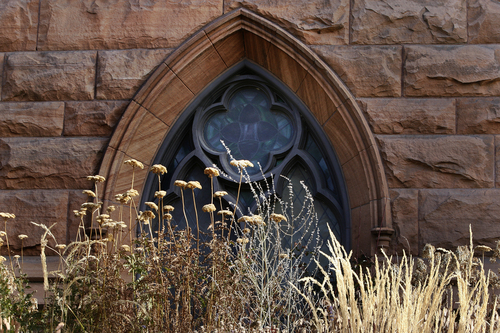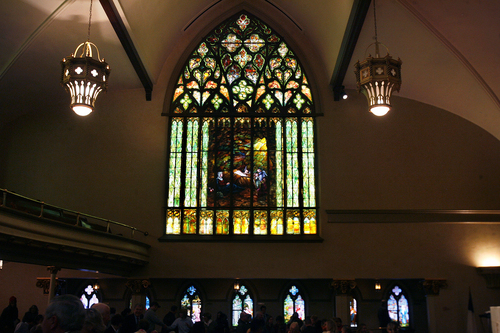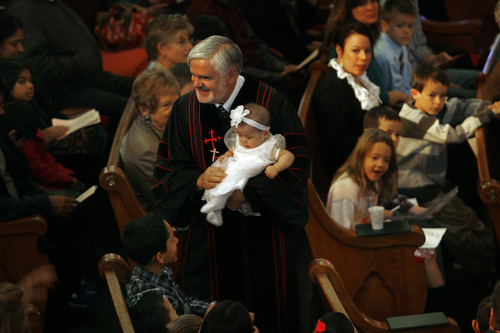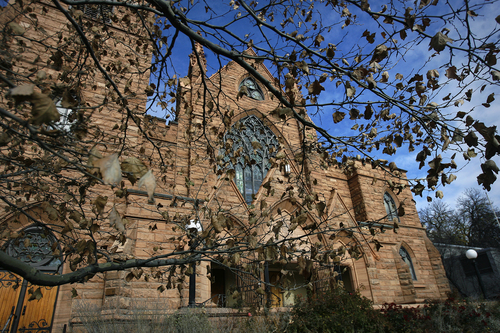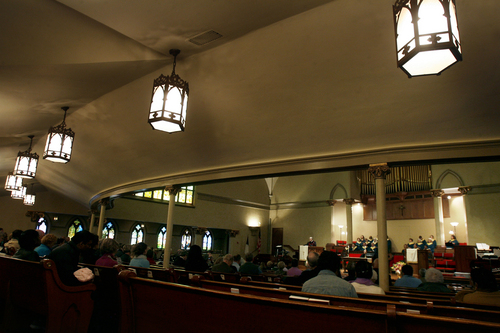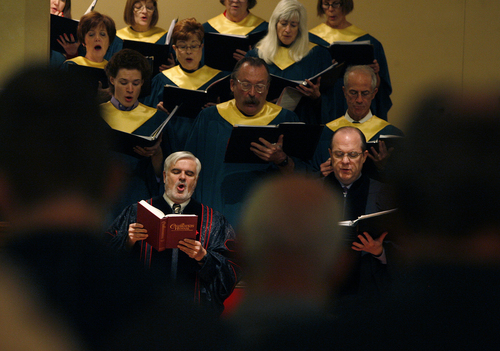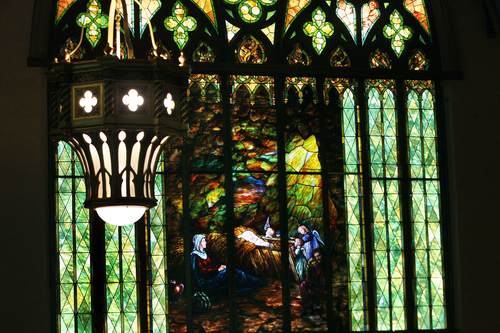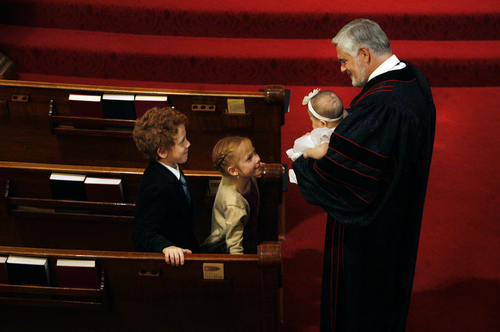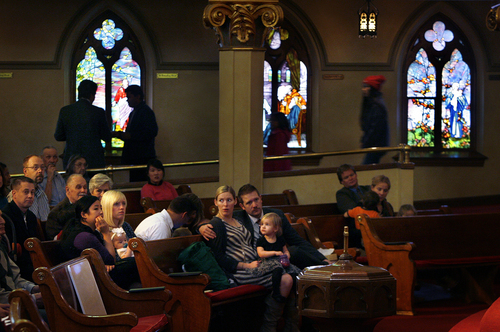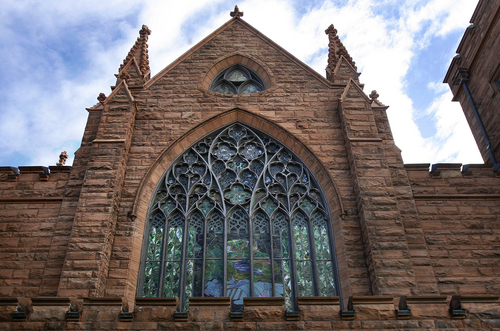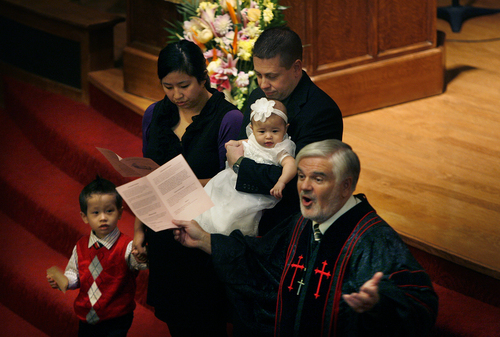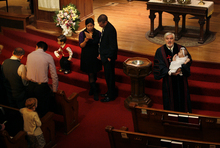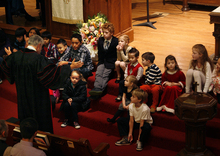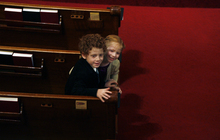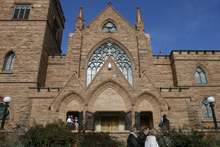This is an archived article that was published on sltrib.com in 2013, and information in the article may be outdated. It is provided only for personal research purposes and may not be reprinted.
John Calvin likely would be horrified by the exquisite interior of Salt Lake City's First Presbyterian Church, with its stunning stained glass, raised communion table and Advent candles.
The Protestant reformer, considered the father of Presbyterianism, preferred an austere décor. He would opt for a plain table set on the floor to ensure it wouldn't be confused with a Catholic altar.
The Rev. Michael Imperiale, longtime pastor at the salmon-colored sandstone church, notes such disapproval with a sly smile, but quietly relishes the beauty of its sanctuary.
"When you sit down in here, your mind and heart are drawn upward," says Imperiale, alluding to lofty notions of God, heaven and the great beyond.
The subtle oval formed by the oak pews, the rich, red carpet, the vaulted ceiling, light as it pours through the east and south windows, the openness of the chancel, the centrality of the pulpit — all of these create a clear relationship between Word and Sacrament, he says, as spelled out in the denomination's guidelines for sacred spaces.
On top of the physical elements, the fact that First Presbyterian is Utah's third oldest church — after the Mormon Tabernacle and St. Mark's Episcopal Cathedral — makes it even more meaningful, Imperiale says. "It is a privilege to be the pastor of such a historic church."
Indeed, the church has looked out on a parade of history along South Temple since it was built 110 years ago.
Small beginnings • The Rev. Josiah Welch arrived in Salt Lake City on Oct. 1, 1871, and preached his first sermon in a livery stable to a dozen people, according to the church's official history posted on its website. Mormon prophet Brigham Young had closed "every hall and public place in the city" to outsiders, so "this unsavory stable" was the only place available.
Within weeks, Welch had organized the First Presbyterian Church with that handful of believers.
Three years later, the congregation erected its first church on the corner of 200 South and 200 East at a cost of $29,500. It could hold about 500 worshippers.
Presbyterians also were dedicated to education, opening some 36 mission schools and four academies that would ultimately serve more than 50,000 children. The Collegiate Institute — later to become Westminster College — was established in the basement of First Presbyterian, and for decades the pastor was also its president.
After Utah gained statehood in 1896, the Presbyterians — with more than 700 regularly attending Sunday school — had outgrown their building. They bought land at the corner of C Street and South Temple, the history site says, and hired prominent Utah architect Walter E. Ware to design a new church.
Ware modeled the new edifice after Carlisle Cathedral in England with a Scottish Gothic Revival style. The builder, church member Alexander Carpenter, used red sandstone from Red Butte Canyon above Fort Douglas, the church's self-guided tour script says. It was cut and "hauled to the C Street site by horse-drawn wagon and set in place with a series of ropes, pulleys and considerable human effort."
The cost for the building and lot: $175,000.
After two long years of this arduous process, the church opened April 16, 1905.
"One thousand strong marched from the old church," the history says, "to the beautiful new church for the first service."
The new church featured three large stained-glass windows, designed by two brothers from Minneapolis, Robert and Thomas Giles. They told the story of Jesus' life — from the manager through his resurrection.
A storm blew out the east resurrection window in October 1906. It was painstakingly re-created, with three crosses added.
Another seven memorial stained-glass windows line the west side: the Madonna and Child; Jesus Disputing With the Doctors in the Temple; the Beseeching Christ; the Seeking Christ; the Good Shepherd; the Light of the World; and, finally, Ascension Into Heaven.
In 1957, a large addition, carefully matching the sandstone exterior, gave the church more office and classroom space. And, in 2003, the church underwent a long-overdue due refurbishing.
"The remarkable spatial qualities of the sanctuary had been tainted by the inevitable ravages of time," wrote Roger Durnst, about the church's renovation in Volume 8 of Utah Preservation magazine. "Its components were worn, faded, scratched, chipped, damaged or soiled."
EMA Architects, hired to upgrade and restore the church, worked diligently — and delicately — to bring back the building's essence in a contemporary era.
Taken together, Imperiale says, the new and old architectural details infuse the space with reverence and devotion to the human and the divine.
A living space • The First Presbyterian congregation, though doctrinally conservative, is deeply committed to being a community center and reaching out to the poor.
It stages concerts, organ recitals and lectures. It hosted one of Jon Huntsman Jr.'s gubernatorial inaugural events, including a speech by Mormon apostle Thomas S. Monson, now the LDS Church's president. It has participated in the annual Las Posadas at Christmas and Good Friday Processional at Easter.
Every year since the early 1980s, on Reformation Sunday (the last Sunday in October), the church offers a unique festival, known as "Kirkin' O' Th' the Tartan," or Blessing of the Tartan, to celebrate the church's Scottish heritage.
" 'Kirk' is the Scottish word for church," according to the church's website, "and a 'Tartan' is the plaid-patterned fabric, usually wool, that clans — or families — use to distinguish themselves from other clans."
Once a month, the church prepares and distributes sandwiches for the homeless at St. Vincent de Paul Soup Kitchen.
The church plays host to a busy preschool and child-care program as well as meetings for Alcoholics Anonymous, Workaholics, Big Brothers, Big Sisters and various Scout troops.
For homeless advocate Pamela Atkinson, who has been a member of the congregation for 17 years, the building expresses in architecture what is meant by Christian service.
"When the sun is on the [stained-glass] windows at the back of the balcony — [showing] Christ in Gethsemane — or to the left — The Tomb Is Empty — during the 11 a.m. service," Atkinson says, "it is like the sun is shining right through an angel. It is spectacular."
If Atkinson, who serves as a church elder, is at the front reading or saying a prayer, she says, "it is a beautiful reminder of why we are there."
True Christians, she says, "not only serve God within the walls of that beautiful building, but outside in the community. We take a bit of the church with us when serving elsewhere."
Calvin would not complain about that.
Twitter: @religiongal —
'Where We Worship' series
O The Salt Lake Tribune is featuring Utah's sacred spaces this year. To read previous stories in this monthly series, go to http://www.sltrib.com
Today • First Presbyterian Church in Salt Lake City —
About First Presbyterian Church
Location • 12 C St., Salt Lake City
Built • 1903
Size • Seats 900 (500 on main floor; 400 in balcony)
Cost • $175,000
Architect • Walter E. Ware
Style • Scottish Gothic Revival
Features • Large stained-glass windows, oak pews, indigenous red sandstone exterior, elaborate pipe organ


